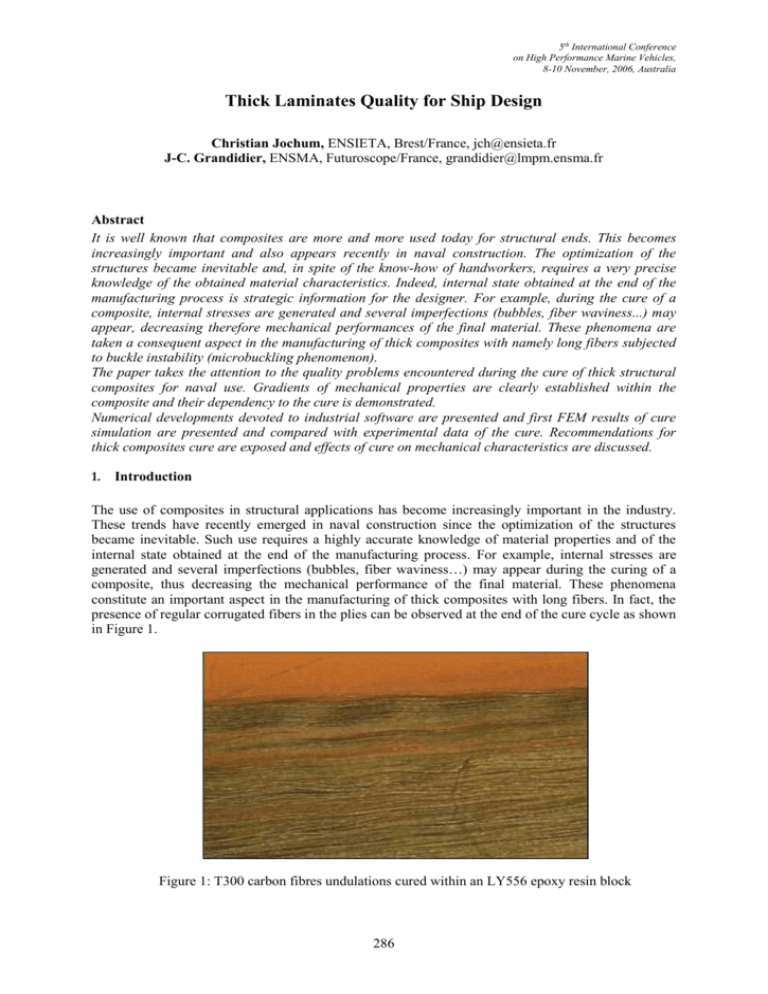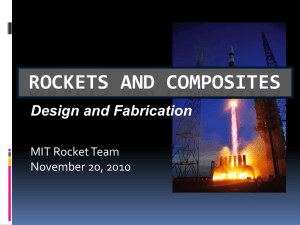CHEMICAL-THERMAL-AND MECHANICAL COUPLING MODEL
advertisement

5th International Conference on High Performance Marine Vehicles, 8-10 November, 2006, Australia Thick Laminates Quality for Ship Design Christian Jochum, ENSIETA, Brest/France, jch@ensieta.fr J-C. Grandidier, ENSMA, Futuroscope/France, grandidier@lmpm.ensma.fr Abstract It is well known that composites are more and more used today for structural ends. This becomes increasingly important and also appears recently in naval construction. The optimization of the structures became inevitable and, in spite of the know-how of handworkers, requires a very precise knowledge of the obtained material characteristics. Indeed, internal state obtained at the end of the manufacturing process is strategic information for the designer. For example, during the cure of a composite, internal stresses are generated and several imperfections (bubbles, fiber waviness...) may appear, decreasing therefore mechanical performances of the final material. These phenomena are taken a consequent aspect in the manufacturing of thick composites with namely long fibers subjected to buckle instability (microbuckling phenomenon). The paper takes the attention to the quality problems encountered during the cure of thick structural composites for naval use. Gradients of mechanical properties are clearly established within the composite and their dependency to the cure is demonstrated. Numerical developments devoted to industrial software are presented and first FEM results of cure simulation are presented and compared with experimental data of the cure. Recommendations for thick composites cure are exposed and effects of cure on mechanical characteristics are discussed. 1. Introduction The use of composites in structural applications has become increasingly important in the industry. These trends have recently emerged in naval construction since the optimization of the structures became inevitable. Such use requires a highly accurate knowledge of material properties and of the internal state obtained at the end of the manufacturing process. For example, internal stresses are generated and several imperfections (bubbles, fiber waviness…) may appear during the curing of a composite, thus decreasing the mechanical performance of the final material. These phenomena constitute an important aspect in the manufacturing of thick composites with long fibers. In fact, the presence of regular corrugated fibers in the plies can be observed at the end of the cure cycle as shown in Figure 1. Figure 1: T300 carbon fibres undulations cured within an LY556 epoxy resin block 286 5th International Conference on High Performance Marine Vehicles, 8-10 November, 2006, Australia In thin composites, this phenomenon also seems to be active as suggested by the study of PALUCH (1994) into long carbon fibers. This author clearly showed that the fibers assume an undulatory form at the end of the cure. Figure 2: Three-dimensional view of T300 carbon fibres progress in an 914 epoxy matrix, Paluch (1994). Fiber waviness can fully assume a sinusoidal shape as shown in Figure 3 and the same results were obtained for T300 carbon fibers in a Synolite 3720 I1 polyester resin. This demonstrates the systematic character of the phenomenon. As fibers were initially straight, waviness observed at the end of cure is the proof of an internal stress state developed during the curing. Figure 3: Example of microbuckling measurements (in micrometers) done on a T300 carbon fibre inside of an LY556 epoxy matrix, JOCHUM (2004). Unfortunately, it has been shown in practice that fiber undulation or waviness characteristics (wavelength and amplitude) has a negative influence on the stiffness and strength of fiber-reinforced composites, MRSE (1990), PIGOTT (1991; 1995), ADAMS (1994), HSIAO (1996), STECENKO (1997), DE MORAIS (1997). Several modelling approaches were used in order to determine this loss of strength. The quality of the predictions depends on the initial value of the wavelength and amplitude of the fiber, which results from the cure process, WISNOM (1990), FLECK (1995), DRAPIER (1997, 1998, 2001), LIU (2004). Currently, no study exists for the prediction of a complete microscopic stress-strain distribution inside 287 5th International Conference on High Performance Marine Vehicles, 8-10 November, 2006, Australia a composite after its cure. Existing models only solve the macroscopic strengthening of a composite, either by means of a parametric study of the description of fiber defects, DRAPIER (2001), kink band approaches, FLECK (1995), or the spectral density of waviness, LIU (2004). The literature does not take the behaviour of the matrix during the cure, fiber-matrix interaction and its consequences on the stress state of the matrix after the return to room temperature into account. The characteristics of fiber undulation at the end of the manufacturing process are seldom presented in the literature. The authors only modelled the fiber waviness with a single harmonic and therefore a range of imperfection angles are considered to determine the actual compressive strength of the material. Figure 4 displays strong fibre waviness effects on ply failure strain that can be three times less in comparison with a theoretical perfect straight fibres ply. 6.5 6.0 5.5 --------- 6.50 5.81 5.12 4.44 3.75 3.06 2.37 1.69 5.0 4.5 4.0 3.5 3.0 Failure strain (%) 5.81 5.12 4.44 3.75 3.06 2.37 1.69 1.00 2.5 Angular defect (°) el = 0.18 mm 2.0 0.1 0.5 1.0 1.5 2.0 2.5 3.0 3.5 1.5 0.13 0.16 0.6 0.3 0.25 0.21 Wavelength of defect (mm) 1.0 0.8 Figure 4: T300 fibre waviness effect on ply failure strain (T300/914) laminate, DRAPIER (2001). In order to compensate for this lack of real information about the description and understanding of fiber waviness, it was decided to first study a single fiber composite. The single fiber approach is a powerful tool for the simple observation and identification of the fiber instability mechanism that appears during the cure. In particularly, quantitative measurements of fiber undulations are possible on a single fiber composite, which shows a good correlation with the cure kinetics. The single fiber approach is obviously questionable since the use of a single fiber involves local stresses that are certainly much different when the fiber volume fraction changes, however, on the other hand, the point at which the instability appears would probably not change when the fiber volume fraction increases. Both in the case of a single fiber and a high volume fraction composite, the instability during the curing is generated by the same chemical shrinkage mechanism. The difference is examined from a structural point of view (single fiber or composite) but the mechanism that triggers the instability remains the same. The resin shrinkage effect on fiber waviness was shown in a previous paper, JOCHUM (2004). To obtain this result two experimental cure cycles were performed on an epoxy sample containing one single fiber. The first cure cycle was used to obtain slow cure kinetics and the second cure cycle to obtain fast cure kinetics. Both cure cycles used the same final cooling phase. Comparisons of the results clearly established that the instability appears during the heating phase of the cure and depends on the parameters of the cure schedule. An instability approach, which takes the evolution of the elastic behaviour of the matrix during the cure into account, was developed and confirms that chemical shrinkage can generate a higher level of stress than the critical level. However, the viscoelastic behaviour of the matrix was not taken into account and this point is critical. Nonetheless, in a recent previous study, JOCHUM (2006), we presented the real-time monitoring of the undulation and description of fibers during the cure cycle of a T300 carbon fiber embedded in LY556 epoxy resin. The mass effects and the non-isothermal analysis were studied in order to gain more insight into the real cure conditions of laminates. Correlations with cure kinetics and glass 288 5th International Conference on High Performance Marine Vehicles, 8-10 November, 2006, Australia transition have shown that fiber undulations appear prior to the crossing of the glass transition temperature (Tg) line during the rubbery state of the matrix. It is then obvious that the initial imperfection of fibers is a key element of the laminate quality and provides highly strategic information for the development of composites for structural applications. Therefore, the aim of this paper is to take the attention of the reader to the quality problems encountered during the cure of laminates. The second chapter of this paper presents essentials results obtained experimentally for gradients of material properties during the curing of thick structural composites for naval use. Cure effects on mechanical characteristics are discussed. Laminate quality predictions are enabled today by numerical developments devoted to industrial software. First FEM results of cure simulation are presented in the third chapter and compared with experimental data of the cure. Some recommendations are then exposed for the curing of thick composites. 2. Experimental results The curing effect on material properties for thick laminates is presented in this section. If one can consider that the curing has no effect on thin laminates properties (less than 1 mm thickness) in regard to the matrix quality, this is not valid as the thickness increases. The chemical thermosetting reaction is thermoactivated on hand and, on the other hand, heat is produced as soon the reaction starts. There is a coupling effect between the thermal and the chemistry of the matrix during the cure more and more important as the thickness increases (mass effect). Following subsection presents results for temperature evolution inside of an epoxy LY556 resin during the cure. 2.1. Local temperature evolution The exothermal behaviours were quantified by the monitoring of the local temperature during the curing of an LY556 epoxy resin. The thermal disruption induced by the thermocouple measurement technique is assumed to be negligible according to the one mm thick thermocouple probe which was plunged into the resin. The results shown in Figure 5 for epoxy resin curings clearly illustrate the existence of exothermal effects, combined with mass effect. 200 150 Temperature (°C) 4,8°C/min ramp up to 138°C 8 mm thick epoxy resin (start at 38°C) 5°C/min + 10min at 144°C 8 mm thick epoxy resin (start at 38°C) 7,5°C/min + 21min at 150°C 3 mm thick epoxy resin (start at 40°C) 100 50 0 0 500 1000 time (s) 1500 2000 Figure 5: Monitoring of the local temperature of epoxy resin during cure and mass effects, SMAALI (2005). Indeed, exothermal effects are related to the local temperature peak that increases with resin thickness and therefore demonstrates mass effects on exothermal behaviour. Moreover, exothermal behaviour depends strongly on the used cure cycle as shown in Figure 5 for the same thickness results. 289 5th International Conference on High Performance Marine Vehicles, 8-10 November, 2006, Australia It is then obvious to conclude that the cure cycle in addition with mass effect induce strong thermal gradients. The development of the thermal gradients can be related to matrix colour gradients as observed in Figure 6 after the return to room temperature. In this Figure, an axial cutting of the obtained matrix cylinder after a 120°C isothermal cure was performed to observe the heterogeneous colour of the matrix which developed after the heating of a 26 g epoxy matrix mass (30 mm thick). Temperature (°C) 20 min at 120°C 10 min at 120°C Heart temperature 300 250 200 150 100 50 0 Oven temperature 0 Thermocouple Epoxy matrix colour gradients 500 1000 1500 2000 time (s) Increase in local temperature of epoxy matrix Figure 6: Mass-induced exothermal effect on matrix colour and local temperature increase, JOCHUM (2006). The thermosetting reaction is therefore affected by the cure cycle and the mass effect. The heterogeneity of the temperature field generates degree of conversion gradients and therefore gradients of chemical shrinkage. This is important information that must be taken into account to understand the development of internal stress within the matrix. 2.2. Degree of cure gradients The degree of cure (or degree of conversion) was calculated by using a classical GOTRO cure kinetics model, GOTRO (1989), established for epoxy amine systems as shown by equation (Error! Reference source not found.) du d n : divJ q r K1 K 2 m 1 dt dt (1) with K1=a1exp (-e1/T) and K2=a2exp (-e2/T) where the corresponding coefficients for the LY556 epoxy resin blend are presented in Table (1). Table 1: GOTRO cure kinetics coefficients for the LY556 epoxy resin system m n a1 a2 e1 e2 0.75 1.25 1.41093 103 2.35865434 106 5917.89 7983.42 s-1 s-1 °K °K The use of the simulation for the determination of the cure kinetics was preferred to the classical differential scanning calorimeter (DSC) analysis, as the exact temperature profile observed in the matrix cannot be easily reproduced in a DSC setup. 290 5th International Conference on High Performance Marine Vehicles, 8-10 November, 2006, Australia A finite difference scheme was used to solve Eq. (Error! Reference source not found.). The temperature input for the simulation is the temperature signal measured in the resin and hence accounts for local exothermal effects during the cure. Results are shown in Fig 7 for heart temperature and edge temperature profile of the resin as displayed in Figure 6. 1 0.9 Degree of cure 0.8 Heart degree of conversion 0.7 Heart degree of conversion 0.6 0.5 0.4 0.3 0.2 0.1 0 0 500 1000 1500 2000 2500 time (s) Figure 7: Degree of cure gradient observed on a 30 mm thick epoxy sample Figure 7 clearly demonstrates that temperature gradients, induced by mass effect as shown in Figure 6, strongly influence the history of the cure. Indeed, degree of cure profile obtained within the matrix block is completely different between the heart and the edge areas of the matrix. The cure profile obtained at heart position corresponds to a fast curing whereas the profile obtained at edge position denotes a significant slower curing. The remaining difference observed at the end of cure between heart and edge positions is around 5%. 2.3. Shrinkage gradients In-situ chemical shrinkage of the epoxy resins was examined by using the Li et al. method, LI (2004), which established a bilinear relationship for cure shrinkage rates versus degree of cure. The obtained bilinear relationship for the LY556 epoxy blend is shown in Figure 8. The total chemical shrinkage rate of 6% is obtained by extrapolating the bilinear relation to a degree of cure of 100%. Degree of cure,% 0% Cure shrinkage,% -1% 0% 20% 40% 60% 80% 100% -2% dy/dx=-0.099 -3% -4% -5% -6% dy/dx=-0.012 55%, -5.5% Total cure shrinkage: -6% -7% Figure 8: Cure shrinkage evolution versus degree of cure (LY556 epoxy resin). 291 5th International Conference on High Performance Marine Vehicles, 8-10 November, 2006, Australia The use of the degree of conversion results for each cure condition recorded at heart and edge positions enable a description of the corresponding cure shrinkage. As displayed in Figure 9 cure shrinkage history is very different between heart and edge positions. time (s) 0% 0 500 1000 1500 2000 2500 -1% Heart shrinkage Cure shrinkage -2% -3% -4% -5% -6% Edge shrinkage -7% Figure 9: Cure shrinkage evolutions at heart and edge positions during the curing (epoxy LY556 resin). This is to be related to the corresponding cure kinetics profile as shown in Figure 7. The hardening of the matrix starts first on the edges, whereas the heart is still liquid. However, exothermal behaviour in addition with mass effects increase the temperature profile and, as a consequence, the degree of cure profile applied on the resin as the blend is located more and more far from the edges, with a maximum at the heart position. Consequently, shrinkage gradients are observed during the curing. Even if at the end of the cure the total shrinkage tends to be the same, the history of its evolution is significantly different within the matrix block. This out of phase evolution of cure shrinkage is one of the basis mechanisms that must be taken into account for internal stress development and especially for thick matrix. 2.4. Mechanical properties gradients Even if the difference of degree of cure observed between edges and heart position as shown in Figure 7 is around 5%, mechanical properties are not the same. Indeed, as explained before, mass effects in addition to exothermal behaviour of the curing lead to thermal gradients inside of the matrix and thus different curing histories. The crosslinking reaction of the blend is therefore not done in the same way throughout the block of resin and consequently the molecular branching differs. Thus, even if the obtained degree of cure is the same, because of differences in the thermal history of the curing, the corresponding mechanical property differs. This is clearly observed by DMA-TMA analysis, (Dynamical Mechanical Analysis-Thermal Mechanical Analysis), of the curing as shown in Figure 10. In this figure, the elastic shear modulus evolution versus time differs significantly between two matrices cured with a continuous 1°C/min oven heating and a 120°C isothermal oven heating. DMATMA tests were performed on thin samples of resin poured into shear plates in order to control as best as possible the local temperature applied on the blend for the curing. The matrix is cured inside of the DMA oven before the start of the cooling analysis. Elastic moduli differences observed are around 8% at the end of the final cooling step and return to room temperature. This result highlights the importance of the thermal history of the curing. The continuous 1°C/min ramp was performed up to 180°C whereas the 120°C isothermal cure never exceeds 140°C for the matrix temperature. Thus, this does not lead to the same material at the end of cure since the elastic moduli growth during the cooling and the final value reached are not equal. This result is to be related to thick matrix cure where strong thermal gradients exist and demonstrate the heterogeneous aspect of the mechanical properties of the matrix throughout its thickness. 292 5th International Conference on High Performance Marine Vehicles, 8-10 November, 2006, Australia 3. FEM cure simulation Elastic shear modulus G'(MPa.) As presented previously, internal stresses generating undulation defects during the curing of a thermosetting matrix result from a complex process where thermal, physicochemical, viscosity and mechanical phenomena are mixed. This complexity is increased by the both thermo activated and exothermal behaviors of the thermosetting chemical reaction of the resin. Moreover throughout the cure, mechanical characteristics are evolving with temperature and degree of conversion of the chemical reaction. Tools using advanced finite elements made their appearance. However these tools are established on formulations where all the couplings are not taken into account. The modeling of these phenomena coupled with the temperature and with the mechanics seems to be never have been approached previously. Thus, the aim of this research is to build up a simulation tool for the process of cure, based on coupling models taking into account the mechanics, the thermal, the diffusion and the chemistry. This is a strategic way to understand internal stress mechanism appearing during the cure. It should lead to a better description of material characteristics gradients present at the end of cure and namely the internal residual stress state obtained. This section presents the methodology of a coupling model for the cure. An experimental device devoted to cure shrinkage and matrix in-situ temperature measurements is presented. Results of the proposed simulation tool are compared with the experimental data and are very encouraging. 1200 1000 1°C/min ramp cured matrix 800 600 120°C isothermal cured matrix 400 200 0 220 180 140 100 60 20 Temperature (°C) Figure 10: Cure conditions effect on matrix elastic shear modulus growth during the final cooling for return to room temperature for an LY556 epoxy resin, 1Hz. DMA analysis. 3.1.1. System modelling approach The thermosetting system is supposed to be a traditional continuous medium, made up with a blend of resin, hardener and accelerator, BOWEN (1976). The macroscopic representative elementary volume (REV) is considered homogeneous, open and characterized by averaged physical units defining the mixture. Thus, only the averaged behaviour of the REV is involved here. It is an acceptable assumption, since experiments of mechanical characterization exhibit only the macroscopic behaviour. The diffusion of each “species” is assumed to be described by a molecular diffusion phenomenon following a Fick law type. It is controlled by the gradients of concentration or mass ratio of the various species. In this REV the various elements react between them in order to create the matrix. This evolution of the mixture, governed by the equations of the diffusion and the equations of the chemistry, is taken into account in the equations of the thermal and of the mechanics. 3.1.2. Mass balance. 293 5th International Conference on High Performance Marine Vehicles, 8-10 November, 2006, Australia In order to simplify the modelling approach an unique reaction is only taken into consideration, in spite of the fact that many reactions are evolving during the thermosetting reaction of an epoxy resin. Moreover the accelerator mass ratio, which is very low in comparison with other current species, can be neglected. On the other hand, its effect is reintroduced through the kinetics law of the chemical reaction rate. These assumptions do not reduce the generality of model. The total mass conservation in the REV leads to a relation between the mass ratio of the resin, of the hardener and of the obtained matrix, 3.1.3. Mechanical balance. In regular points of the non-polar body, the mechanical balance leads to the classical equation of movement involving the Cauchy stress tensor applied onto the mixture and f the mass density of forces applied onto the REV. Accelerations have been neglected because the cure is supposed being a quite a slow process. 3.1.4. Thermodynamic balance, state laws. The total energy conservation of the system, as described by the first principle of thermodynamics, is expressed locally in the following traditional form: u;˙ = : ;˙ - div Jq + r. (1) where ‘u’ is the specific internal energy of the mixture, the infinitesimal strain tensor associated with the mixture, Jq the heat flux and r the external heat supply per unit volume. Note that ‘:’ denotes the double contract product. The thermodynamic system is assumed to be close to its equilibrium. The classical assumption of a local accompanying state allows us to describe at any time the state of a given material EV by a set of state variables. One admits first the existence of one homogeneous absolute temperature T valid for the mixture and for all its constituents. In classical linear viscoelasticity framework, total strain is classically separated into elastic and inelastic (non reversible) components, denoted e and v respectively, like = e + v . From a constitutive law point of view, a Kelvin-Voigt model was considered and this mechanical model assumes also a partition of the stress tensor as = an + vr, containing an inelastic part an and a viscous reversible part vr. Of course, it is a first level model to represent a viscoelastic behavior for a polymer, but the aim of this work is to present a modelling approach. It is clear that it cannot be used to predict exactly the complete mechanical behaviour evolution of the mixture during the cure. However, it could be effective by taking into account the effect of temperature and degree of cure on mechanical characteristics, while restricting the implementation work in a finite element industrial code (F.E.M. analysis). Thus, assumptions presented before allow the material state to be defined by following variables: temperature T, elastic and viscous strains, e and v, resin and hardener mass ratios Yp and Yd. The specific free energy potential depending on all these variables = (T, e, v, Yp , Yd) and under the assumption of a normal parameter setting, GERMAIN (1983), laws can be established. By considering the framework of small perturbations, i.e. infinitesimal strains and few thermal and mass variations, the second order development of the potential allows the construction of coupling linear behaviour laws. 3.1.5. Entropy description – second principle. Opened systems whose evolution is in progress are considered here. Within the general framework of opened systems, the total differential of the mass entropy checks the fundamental Gibbs generalized relation. 294 5th International Conference on High Performance Marine Vehicles, 8-10 November, 2006, Australia 3.1.6. Potential of dissipation - Complementary constitutive equations. A second potential is introduced in order to define the evolution laws, namely the pseudo-potential of dissipation, more exactly its dual form d* is obtained by a Legendre-Fenchel transformation and can be written as a function of an, temperature and chemical potential gradients and degree of cure. If dissipation phenomena are supposed to be governed by linear laws (small perturbations close to the thermodynamic equilibrium) and by the assumption of the validity of the Curie principle, the dual potential d* can be expressed under a quadratic form 3.2. Description of the cure to simulate Figure 11 shows the experimental device used by SMAALI (2005) and modelled by 3D nodes meshing by JUGLA (2005) for the cure of the LY556 epoxy resin. Liquid resin is poured into a metallic cylinder up to the half of its capacity. The assembly is airtight and plunged into a sand mould to assume a homogeneous heating of the cylinder by an electric plate. Internal air pressure and temperature are monitored throughout the cure done with a 0.6°C/min ramp followed by an isothermal step around 85°C. A special protocol taking into account gas emission during cure and based on perfect gas rules allows the calculation of volume variations induced by the chemical reaction during the cure cycle. Experimental data provided are chemical shrinkage during cure, temperature elevation T2(t) produced by exothermal effects of thermosetting reaction of epoxy cure and temperature boundary conditions T1(t) applied by the heating. 136 Figure 11: Experimental device for epoxy cure data and 3D 20 nodes meshing of the resin block Only a quarter of the resin block was meshed due to the symmetry of problem. Outputs were selected on indicated element. 136 located close to the center point of cylinder resin block. 3.3. FEM Simulation. Modelling approach proposed in this paper is applied to the cure of an LY556 Ciba-Geigy epoxy resin. Mass ratios employed are following: 15.789g of LY556 pre-polymer, 14.211g of HY917 hardener. The very low mass of accelerator is neglected for the simulation for further mass ratios evolutions of pre-polymer and hardener. However, effects of accelerator are taken into account by cure kinetics simulations coefficients based on GOTRO differential equation of cure kinetics. Thus, aims of the simulation will be the numerical determination of temperature field, displacement field, degree of conversion of the reaction, strain field and stress field during the thermosetting reaction of the LY556 epoxy resin. Precise details for numerical implementations are provided by RAMBERT (2005). Validity of numerical implementation was first tested with Abaqus 6.3 FEM thermoelastic solutions. 295 5th International Conference on High Performance Marine Vehicles, 8-10 November, 2006, Australia According to long time of computation induced by viscoelastic calculations exceeding a week, only elastic simulations without species diffusion could be done. User element library (UEL) developed contains therefore four degrees of freedom (three axis displacement and temperature). Fortran 77 programming language was used for UEL implementation into the finite element calculation software Abaqus 6.3. A 20 nodes isoparametric three-dimensional element with quadratic interpolation functions was necessary to solve the coupling model. 3.4. Results. Due to too long calculation time only couplings between chemistry, thermal and mechanics were considered for FEM cure simulations in the field of linear elasticity. Figure 12 shows temperature history obtained by simulation during the cure. Data are tested with several specific heat (Cp) values in addition to degree of cure dependency. Figure 13 shows very encouraging results obtained by simulation of displacement field on element 136. Strain was calculated assuming small perturbation context. 430 1.0% Temperature (°K) 410 390 0.0% 370 -1.0% Longitudinal strain (axe3) time (s) 0 Cp=700 [J.K-1.Kg-1] Cp=1325 [J.K-1.Kg-1] Cp cure dependant Experimental 350 330 310 -2.0% 3000 6000 9000 12000 15000 Experimental -3.0% Cp cure dependant 290 -4.0% 0 3000 6000 9000 time (s) 12000 15000 Cp=700 [J.K-1.Kg-1] -5.0% Figure 12: Local element 136 temperature history during cure Figure 13: Chemical shrinkage history during cure Temperature evolution is quite similar in the range of Cp considered. Exothermal effect is obtained and is in the right magnitude level. However, a significant difference of characteristic time is observed. This denotes a strong dependency of simulation results to initial chemical potentials introduced since they are representative of latent heat of the reaction. Results obtained on element 136 are compared with experimental macroscopic chemical shrinkage established by SMAALI (2005) using internal pressure and temperature evolutions recorded during cure. Encouraging results are obtained by simulation of displacement field. Strain was calculated within the small perturbation context. 4. Conclusion and Discussion This works highlights the quality dependency of laminates with the process of curing. The main factor is the thermal history applied during the curing within the matter. As the thickness increases (more than 3-4 mm), the coupling effect between the thermo activated and exothermal behaviour of thermosetting systems cannot be neglected. Strong thermal gradients appear during the curing, inducing therefore degree of cure gradients. The matrix in progress is more and more heterogeneous and gradients of mechanical properties are generated. Moreover, the chemical shrinkage associated to the thermosetting reaction is able to destabilise the fibre alignment. The quality of the laminate obtained is therefore quite different from the theoretical considerations that designers used to apply. This is especially critical for thick laminates and must be taken into account for the design. 296 5th International Conference on High Performance Marine Vehicles, 8-10 November, 2006, Australia Of course even if post mortem tests can be done, they are usually expensive and time consuming. On the other hand several models exist to take into account laminate quality by either fibre waviness parameters and/or matrix heterogeneity description in order to improve as much as possible structural design usually done by computational mechanics. But they all require input data of the laminate assumed quality. The finite element simulation was therefore considered as a possible and strategic way to understand internal stress mechanism appearing during the cure. A numerical tool coupling mechanical, physical and chemical phenomena was developed on the basis of developments presented above and implemented into an industrial FEM code. First results presented in this paper are very positive and made the demonstration of the applicability of finite element modelling approach to provide local information during the cure. Mid-term objective is to build up a predictive tool, able to grasp finely all the process of cure, namely for thick composites. Finally, while waiting for complete developments of such simulation tools of the curing process, the best advice for thick laminates manufacturers in order to improve the quality is to slower the cure cycle as the thickness increases. Thermal load is an important factor for thick thermosetting laminates quality since the coupling effect between the thermo activated and exothermal behaviour is becoming more and more pronounced with mass effect. 5. References Adams DO, Hyer MW. (1994): "Effects of layer waviness on the compression fatigue performance of thermoplastic composite laminates", Fatigue, Vol.16, pp.385-92. Bowen R. M. (1976): "Mixtures and EM Field theories", Continuum physics vol III, Academic Press. De Morais AB, Marques AT.(1997): "A micromechanical model for the prediction of the lamina longitudinal compression strength of composite laminates", J Compos Mater, Vol.31(14), pp.1397412. Drapier S, Grandidier JC and Potier-Ferry M. (1998): "A non-linear numerical approach to the analysis of microbuckling", Composites Science and Technology, Vol.58(5), pp.785-790. Drapier S, Grandidier JC and Potier-Ferry M. (2001): "A structural approach of plastic microbuckling in long fiber composites: comparison with theoretical and experimental results", International Journal of Solids and Structures, Vol.38 (22-23), pp. 3877-3904. Drapier S, Grandidier JC and Potier-Ferry M.(1997): "Theoretical Study of Structural Effects on the Compressive Strength of Laminates Composites". Compte Rendu de l'Académie des Sciences, Paris Vol.324 Série II b, pp.219-227. Fleck NA, Deng L. & Budiansky B.(1995): "Prediction of Kink Width in Fiber Composites", Journal of Applied Mechanics, Vol.62, pp.329-337. Germain P. (1983) :, Q. S. Nguyen, P. Suquet. ASME J. Appl. Mech., Vol. 50, pp.1010. Gotro et al (1989): "Viscosity modelling during epoxy resin cure", Polymer engineering and science, Vol.29, 14/15, pp. 1743-61. Hsiao HM, Daniel IM. (1996): "Effect of fiber waviness on stiffness and strength reduction of unidirectional composites under compressive loading", Composites Science and Technology, Vol.56, pp.581-93. Jochum Ch. (1999) : "Microflambage des fibres dans les composites stratifiés à fibres longues. " Ph.D. Thesis University of Metz France. 297 5th International Conference on High Performance Marine Vehicles, 8-10 November, 2006, Australia Jochum Ch., Grandidier J.C. (2004):"Microbuckling elastic modelling approach of a single carbon fiber embedded in an epoxy matrix." Composites Science and Technology, Vol.64(16), pp.2441-2449. Jochum Ch., Grandidier J.C., Smaali M.(2006): "Experimental study of long T300 carbon fiber undulations during the curing of LY556 epoxy resin." Composites Science and Technology, in press. Jugla G. (2005): “Contribution à la modélisation multi-physique de la cuisson d’une résine époxy, étude des couplages”, Ph.D. Thesis University of Poitiers, France. Li C et al.(2004): "In-situ measurement of chemical shrinkage of MY750 epoxy resin by a novel gravimetric method. " Composites Science and Technology, Vol.64, pp.55-64. Liu D., Fleck N.A., Sutcliffe M.P.F. (2004): "Compressive strength of fiber composites with random fiber waviness". Journal of the Mechanics and Physics of Solids, Vol.52,pp. 1481 - 1505. Mrse A, Piggott MR. (1990): "Relation between fiber divagation and compressive properties of fiber composites", 35th international SAMPE symposium, pp. 2236-2244. Paluch B.(1994) : "Analyse des imperfections géométriques affectant les fibers dans un matériau composite à renfort unidirectionnel". La recherche aéronautique ; Vol.6, pp. 431-448. Piggott MR, Lam PWK. (1991): “Fatigue failure processes in aligned carbon-epoxy laminates”, Composite materials: Fatigue and fracture, Vol. 3, Philadelphia: ASTM Spec Tech Publ 1110; pp. 686-95. Piggott MR.(1995): "The effect of fiber waviness on the mechanical properties of unidirectional fiber composites-A review", Composites Science and Technology, Vol.53, pp.201-5. Rambert G., Grandidier J.C. (2005): European Journal of Mechanics - A/Solids, 24, p.151168.Discussion. Smaali M. (2005): “Contribution à l’étude expérimentale du phénomène d’ondulation d’une fibre de carbone noyée dans une résine thermodurcissable tout au long de la cuisson”, Ph.D. Thesis University of Poitiers, France. Stecenko T, Piggott MR. (1997): "Fiber waviness and other mesostructures in filament wound materials", J Reinf Plast Compos, Vol.16, pp.1659-74. Wisnom M.R. (1990): "The effect of fiber misalignment on the compressive strength of unidirectional carbon fiber/epoxy", Composites, Vol. 21(5), pp.403-407. 298







